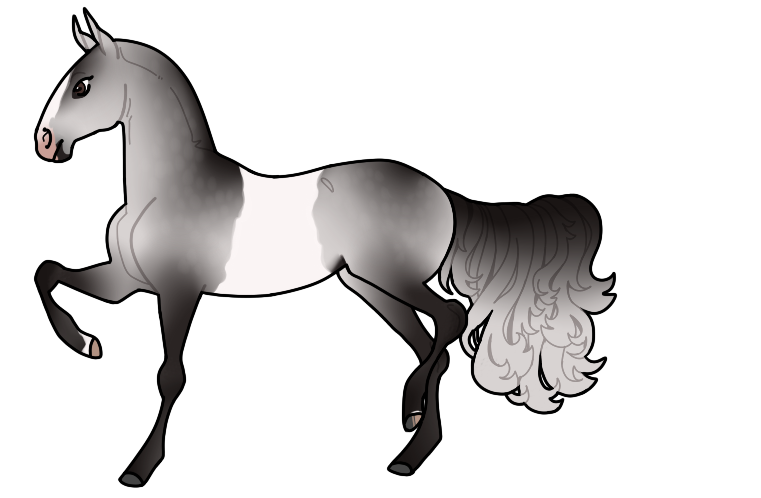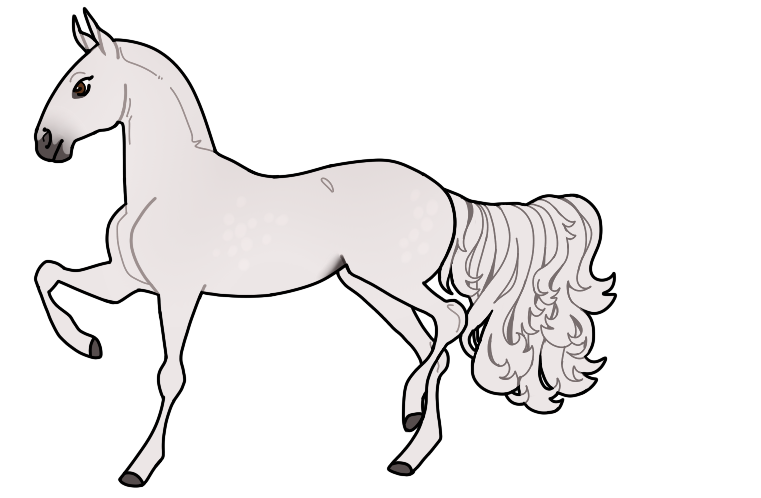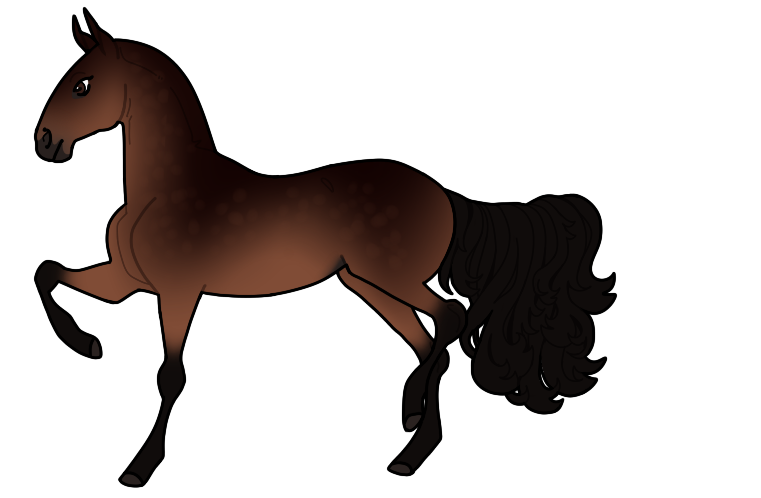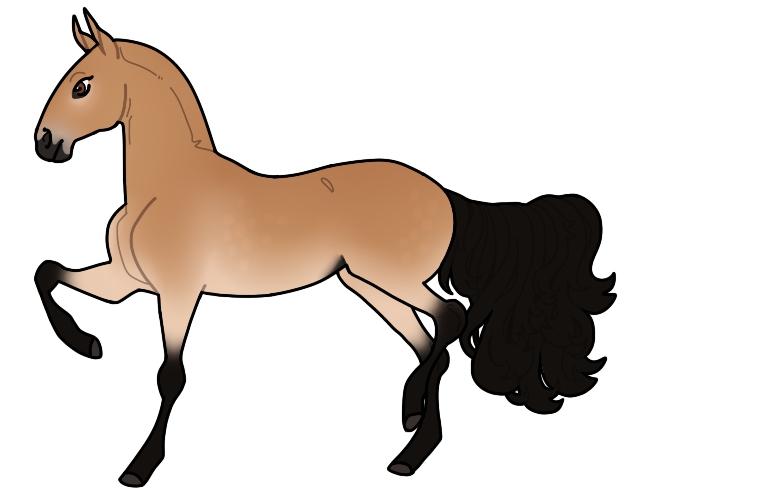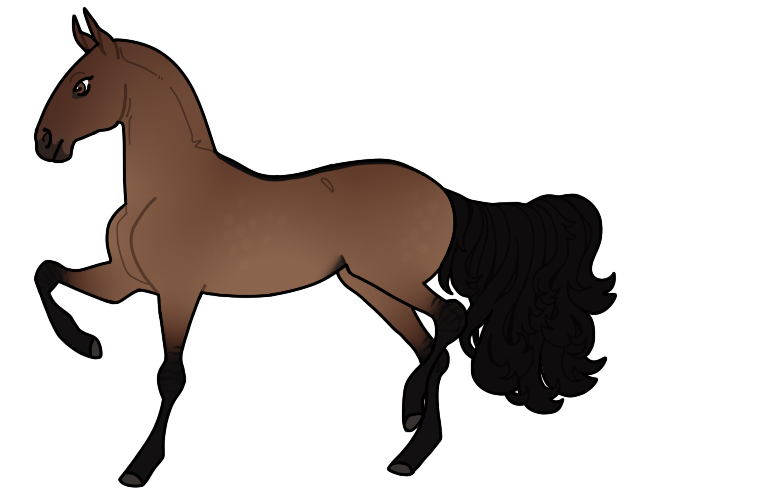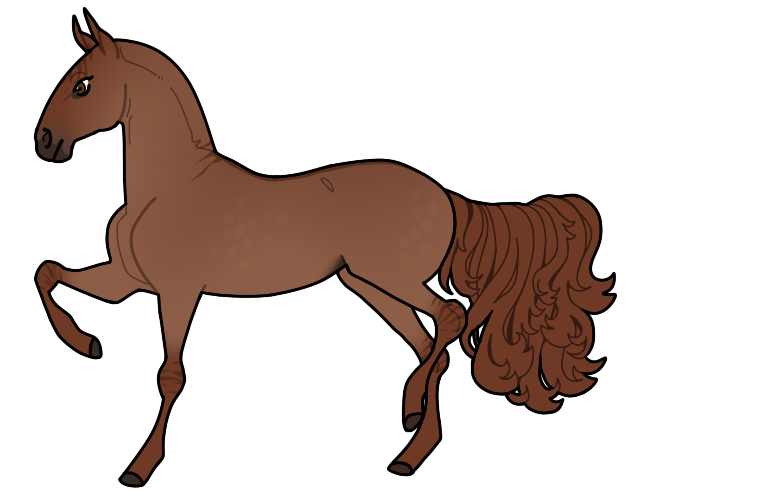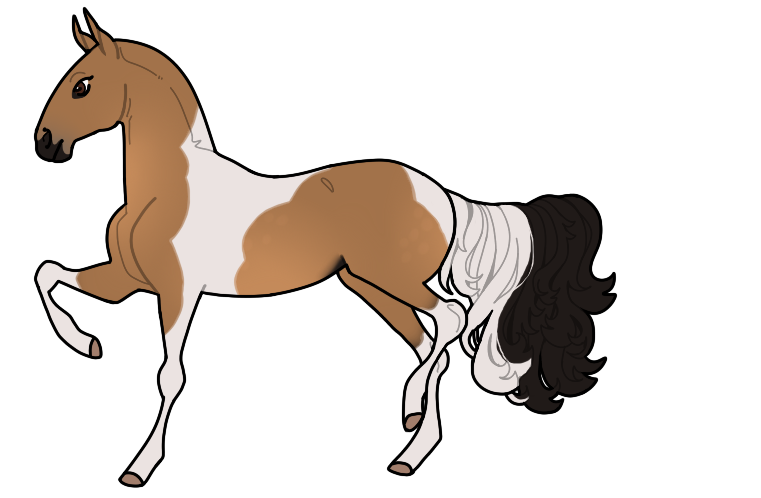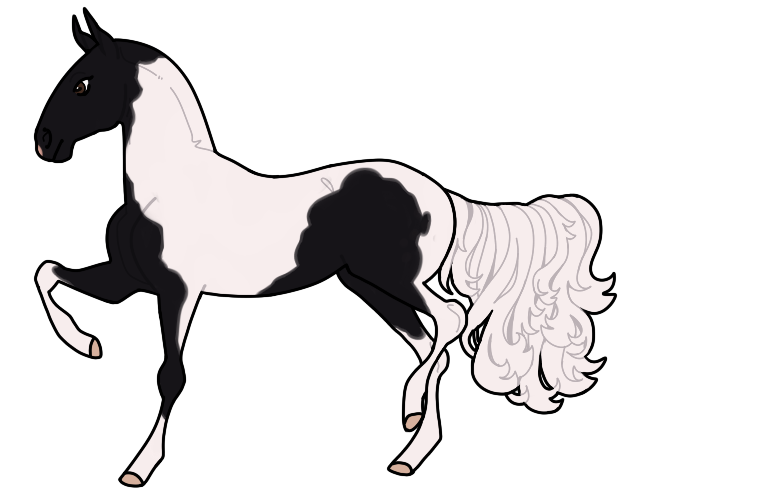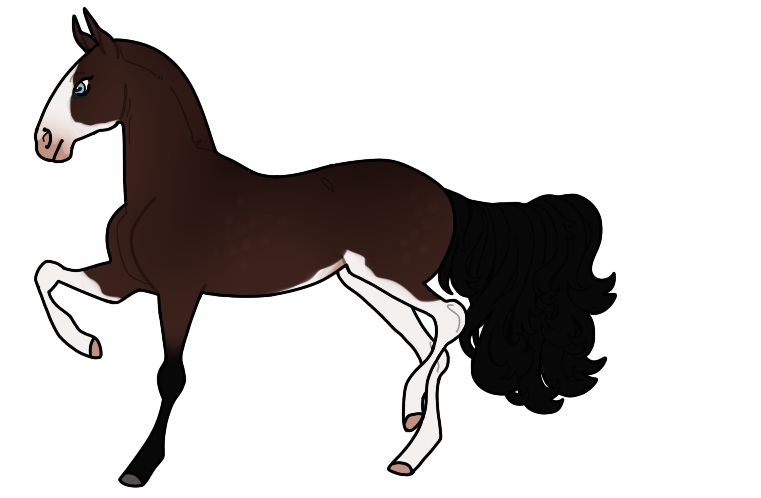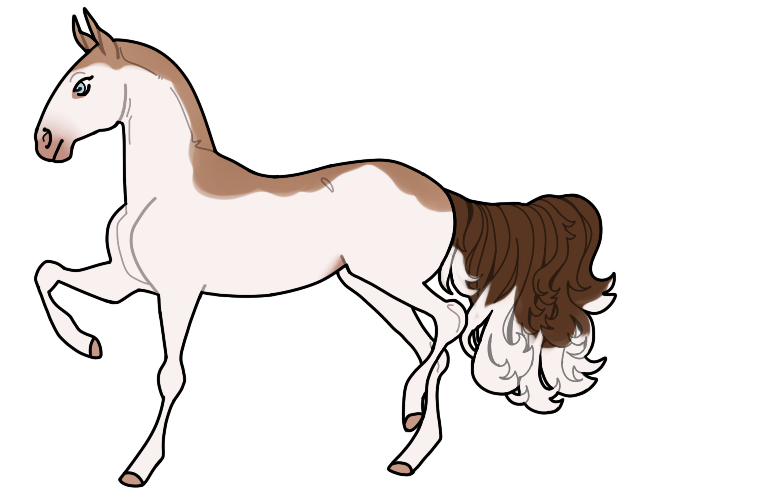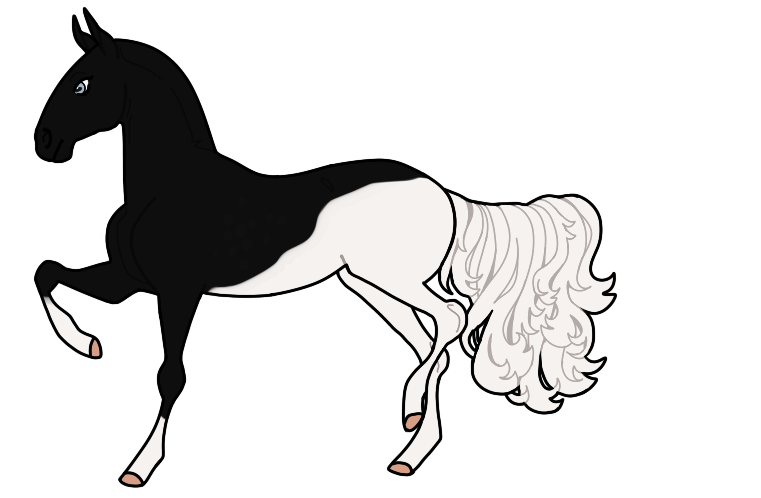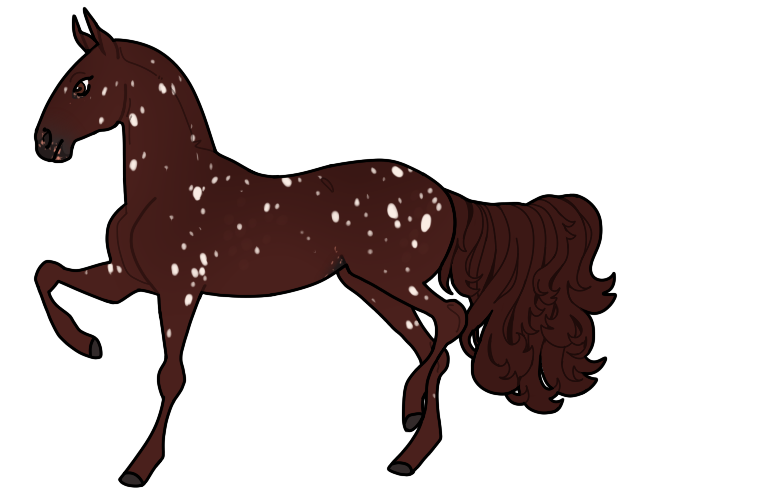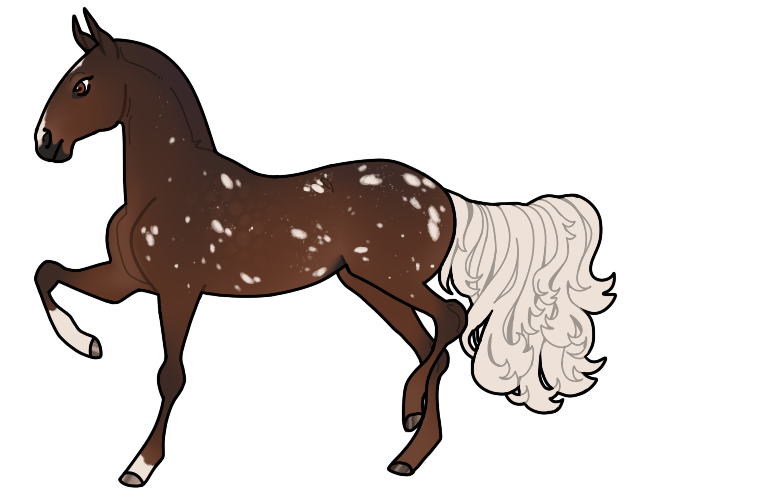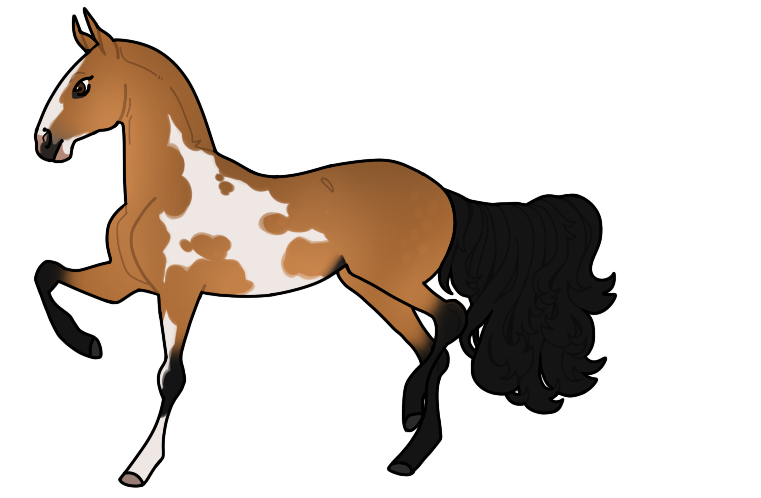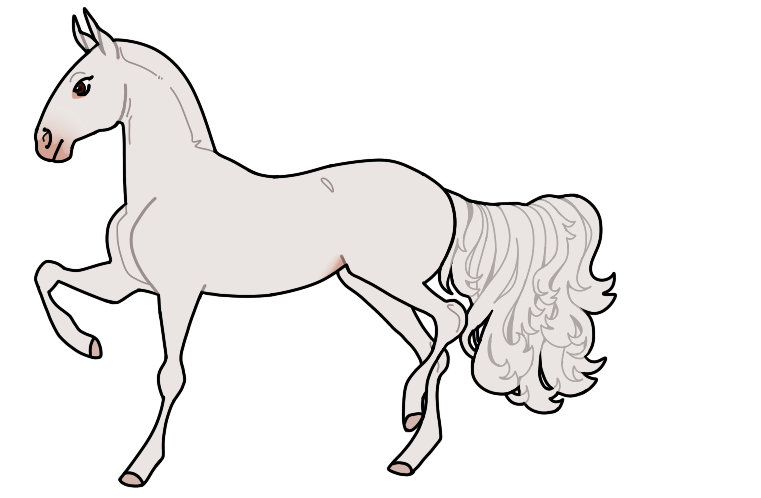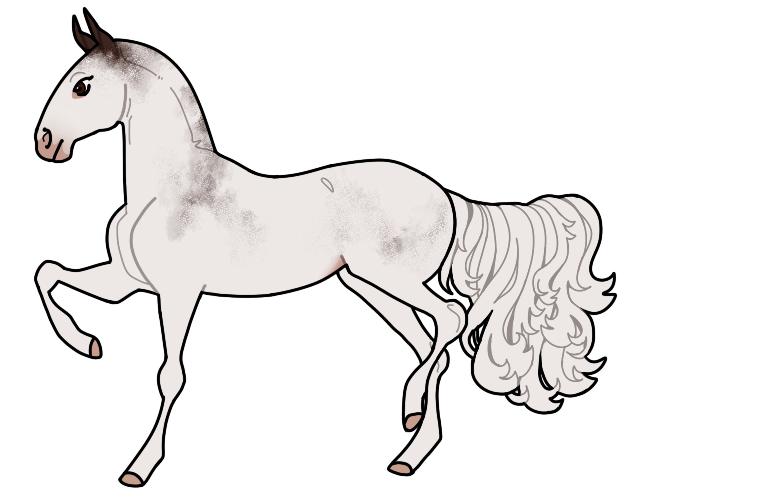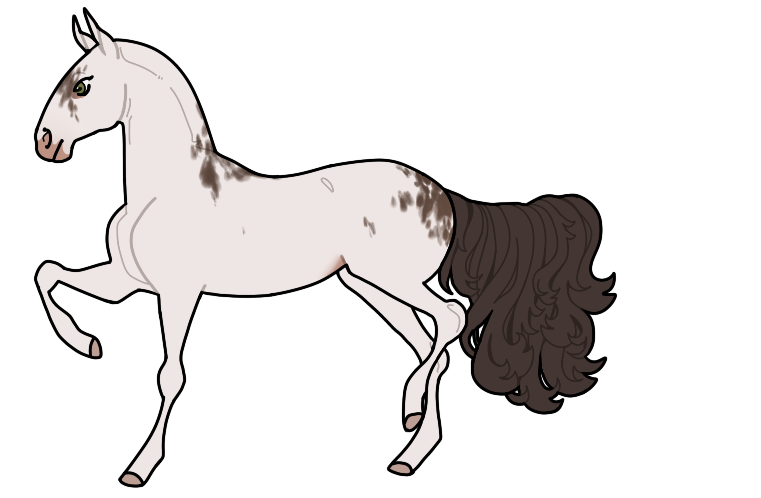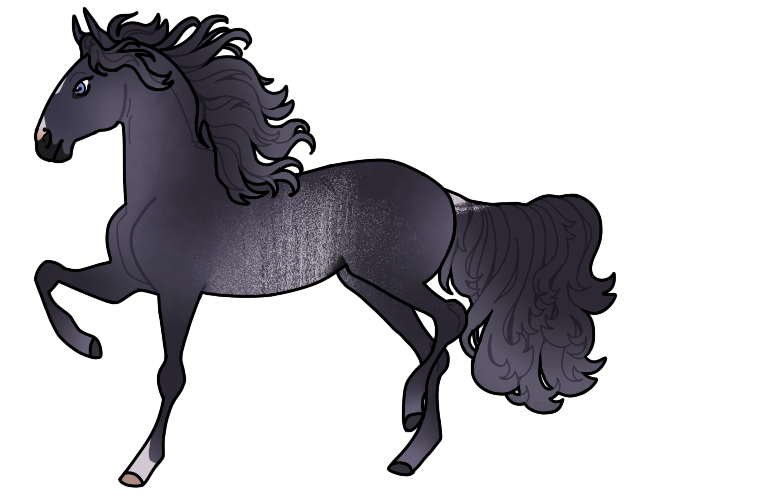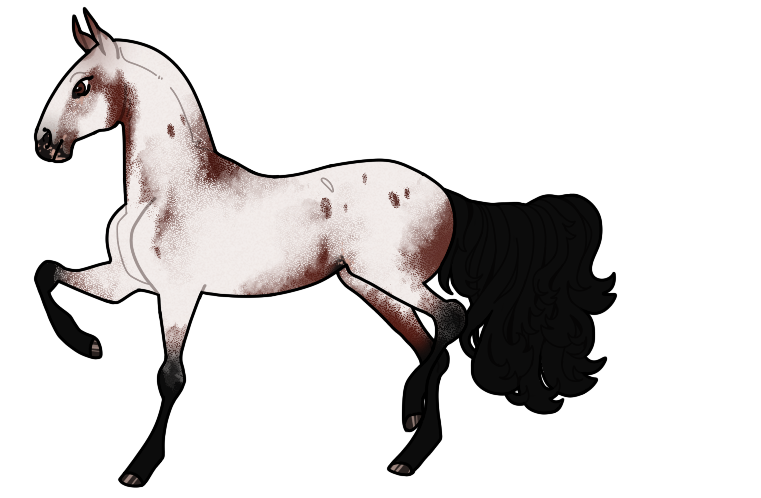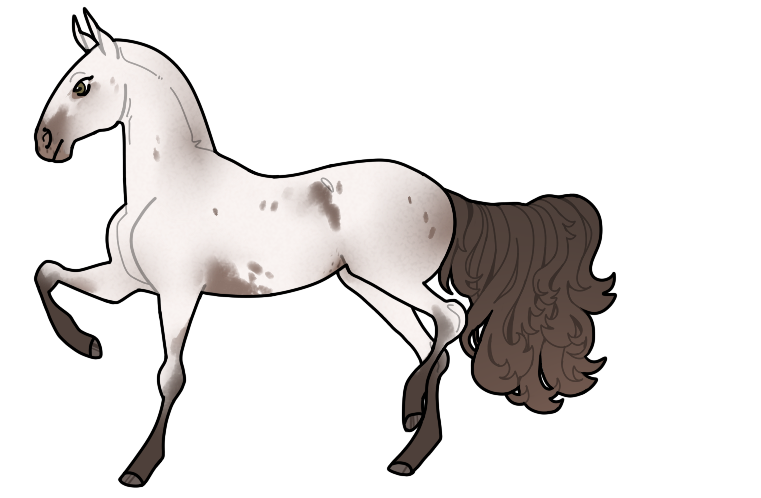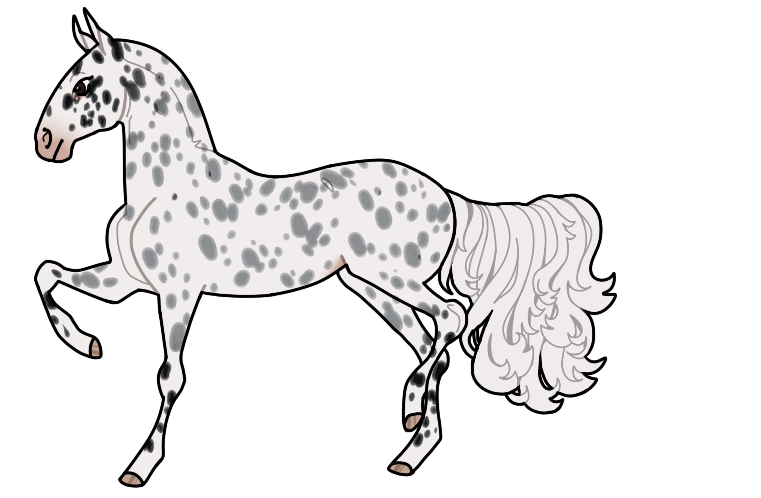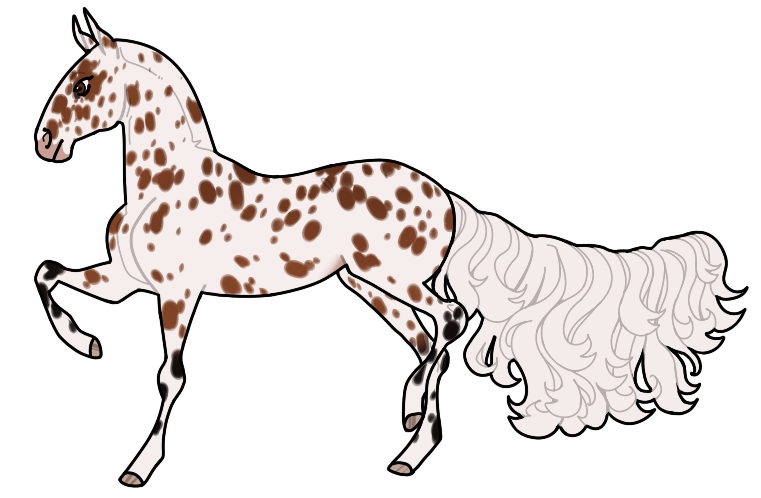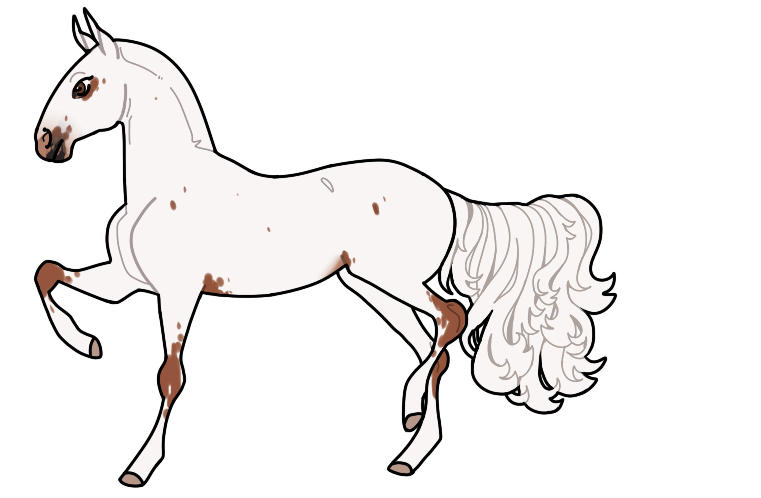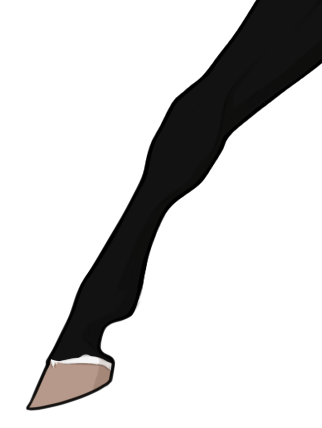Design Guide
Grey (Common)
Genetics: G_
Locus: G
Overview:
- Greys are born as their base color and will progress toward white throughout their lives.
- You may design your horse at any stage of grey as long as it meets the minimum.
- Body greying should originate from the neck/throat, flank, armpit, muzzle, and eye areas and spread from there.
- Mane/Tail: Gradually lightens with the coat over the horse's lifespan; lightest at the ends.
- Skin: No effect
- Eyes: No effect
Variations:
- Fleabitten Grey: Body is lightened to white or near-white, with small "fleabite" spots dispersed across the entire body. Fleabites should be the base color, and should be present across the entirety of the coat, except where covered by white markings.
- Bloodmarked: Can be added to any form or stage of grey. Bloodmarks are patches of color unaffected by grey, most often seen on Fleabitten Grey as an area of concentrated fleabites. These patches will show the base color beneath with no lightening. Edges should be textured.
Interactions:
- Rift: Will gradually desaturate Rift throughout the lifespan, but does not always cause it to lighten/grey out.
Range:
- Minimum: Must express obvious lightening in at least 2 of these areas: neck, flank, armpit, face (muzzle/eyes).
- Maximum: Body, mane, and tail are completely white; skin and hooves will remain consistent throughout lifespan.
Flaxen (Common)
Genetics: f_*
* Must be homozygous and on an ee base to show; otherwise carried
Locus: f
Overview:
- Lightens the mane/tail to white or a significantly lightened, desaturated version of the normal color.
- Color is consistent throughout the mane/tail.
Silver (Common)
Genetics: Z_*
* Must be on an E_ base to show; otherwise carried)
Locus: Z
Overview:
- Lightens the mane/tail to grey/greyish-cream or white.
- May have roots matching (or slightly lighter than) original color, or be solid-colored.
- Dark roots should only cover the top third of the tail at most.
Sooty (Common)
Genetics: Sty_
Locus: Sty
Overview:
- Causes blended darkening of the coat, starting from the topline/back.
- May be somewhat isolated to an area but should still be blended out and not overly restricted.
- Should be a darker shade of the color underneath the area, often somewhat desaturated.
- Mane/Tail: May exhibit some darkening at the roots if sooty is in that area.
- Skin: No effect
- Eyes: No effect
Interactions:
- Dun/Roan: May darken the presentation of Dun/Roan but will not fully mask them; lightening/dilution must still be present.
- Black: Does not show on undiluted black (will be Carried on Black, Smoky Black, Blue Roan, etc).
- Bay/Buckskin: On Bay and Buckskin, Sooty may be black rather than just dark.
Range:
- Minimum: May be hidden.
- Maximum: May cover most of the body, leaving the undersides/"soft spots" alone.
Pangare (Common)
Genetics: P_
Locus: Hk | P
HkP = Husky, nP/PP = Pangare
Overview:
- Causes blended lightening of the coat, starting from the facial regions and belly.
- Pangare should be noticeably lighter than the base color, sometimes cream or near white.
- Should not be a stark line, must be blended out.
- Mane/Tail: No effect
- Skin: No effect
- Eyes: No effect
Interactions:
- Dun: May lighten the presentation of Dun but not fully mask the primitive markings.
- Black: Does not show on undiluted black (will be Carried on Black, Smoky Black, Blue Roan, etc).
- Black Pigment: Will not lighten black pigment (such as Buckskin leg points, etc).
Range:
- Minimum: Visible lightening at the eyes, muzzle, and groin/belly.
- Maximum: Visible lightening at the eyes and muzzle, and following the curve of each body section (last example below). Should not reach topline.
Dun (Uncommon)
Genetics: D_
Locus: B | Ty | Cv | Dt | D
CvD = Dun Civet, TyD = Dun Tabby, BD = Dun Bengal, DtD = Primitive Dun, nD/DD = Dun
Overview:
- Dilutes the body, leaving the legs and head alone (may reach the cheek slightly).
- Primitive markings will be present on the knee/hock joints ("leg barring") and topline ("dorsal stripe").
- Primitive markings should be a few shades darker than the points, or black if points are already black.
- Mane/Tail: May exhibit "frosting" at the roots (light guard hairs; blended).
- Skin: No effect
- Eyes: No effect
Interactions:
- Dun Tabby: When Dun and Tabby are present on the same horse, both will co-exist.
- Causes body dilution under the Tabby markings.
- Also causes dorsal stripe and leg barring, but not shoulder barring.
- Dorsal stripe will be on top if darker than Tabby, or underneath if lighter.
- Leg barring should show one or the other on the joint, not overlap.
- Dun Civet: When Dun and Civet are present on the same horse, both will co-exist.
- Causes body dilution under the Civet markings.
- Dorsal stripe and leg barring are not visible as Civet is on top.
- Should not have shoulder barring from Dun.
- Dun Bengal: When Dun and Bengal are present on the same horse, both will co-exist.
- Causes body dilution under the Bengal markings.
- Also causes dorsal stripe and leg barring, but not shoulder barring.
- Dorsal stripe will be underneath Bengal markings.
- Roan: Roan may lighten the presentation of Dun but not fully mask the primitive markings.
- Pangare: Pangare may lighten the presentation of Dun but not fully mask the primitive markings.
Range:
- Minimum: Dilution (lightening) of the body, as well as leg barring and dorsal stripe.
- Maximum: Dilution (lightening) of the body, as well as leg barring and dorsal stripe. Shoulder barring and facial "cobwebbing" that radiates from the forehead.
Roan (Uncommon)
Genetics: R_
Locus: Rm | R
RmR = Merle Roan, nR/RR = Roan
Overview:
- Lightens the body, leaving the head and legs alone.
- Edges should be clearly blended, often most sharp when reaching maximum.
- Ranges in the amount of lightening, from subtle to near-white depending on base.
- Optional features:
- May show "corn spots", small spots/nicks in the roan that expose the base color beneath.
- May show "reverse dappling", dapples that are darker than what's below them.
- Mane/Tail: May have light blending at the roots.
- Skin: No effect
- Eyes: No effect
Interactions:
- Blotted: Blotted may affect Roan.
- Dun: Roan may lighten the presentation of Dun but not fully mask the primitive markings.
- Sooty: Sooty may darken Roan slightly but not fully mask it; lightening must still be obvious.
Range:
- Minimum: Should clearly originate from the top of the butt and blend outward. Visible lightening at least to the withers horizontally. and at least to the belly line vertically.
- Maximum: Lightening up to the edge of the jaw/ears, and just above the knees/hocks.
Tobiano (Uncommon)
Genetics: T_
Locus: T
Overview:
- White marking that extends down from the topline, often beginning at withers and croup.
- Should be fairly smooth at the edges, with large "cutouts" that give smooth curves.
- White markings may have "cat tracks" within them (holes/spots, typically close to edges).
- Does not cause face white outside of natural white bounds.
- Mane/Tail:
- Mane solid white where marking is touching.
- If white touching tail, will be fully white, partial white (vertical), or blended white roots.
- If white not touching tail, will be fully normal color or blended white roots.
- Skin: Pink skin beneath white markings.
- Eyes: No effect
Range:
- Minimum: Socks on at least two legs (at least halfway between pastern and knee/hock).
- Maximum: Color must be present on the head, chest, and groin/flank area. White elsewhere.
Splash (Uncommon)
Genetics: Spl_
Locus: Spl
Overview:
- White comes from the underside of the horse, as if dipped in white paint.
- Can start at the belly without touching the legs, but must be connected to the underside of the horse rather than being free-floating.
- Should follow a fairly smooth line along the marking path, but may have some edge irregularity.
- Can cause extensive white on the face, but should again be relatively smooth.
- Mane/Tail:
- Mane solid white where touching
- If white touching tail, will be fully white
- If white not touching tail, will be fully normal color, or white hair at the tips
- Skin: Pink skin beneath white markings.
- Eyes: Blue (optional)
Range:
- Minimum: May be hidden.
- Maximum: Should have visible, somewhat thick color on at least half of the topline from forehead to tail.
Snowflake Appaloosa (Uncommon)
Genetics: nLp
Locus: Lp | Modified by patn
nLp = Snowflake Appaloosa, nLp patn = Blanket Appaloosa, nLp patnpatn = Leopard Appaloosa
LpLp patn = Snowcap Appaloosa, LpLp = Varnish Roan, LpLp patnpatn = Fewspot Appaloosa
Overview:
- Causes a dispersion of white spots across the body.
- Can range in size, but will typically be around eye to hoof sized, with some being slightly larger or smaller.
- Must cover significant amount of the body, and not be too few as to suggest Birdcatcher Spots, nor too dense as to suggest Snowfall.
- Tends to focus on the body/neck/head, and should be very sparse on the legs if present there at all.
- Mane/Tail: No effect
- Skin: Pink skin beneath white markings, optional pink mottling on unaffected skin.
- Hooves: Optional tan/shell striping.
- Eyes: No effect
Blanket Appaloosa (Uncommon)
Genetics: nLp patn
Locus: Lp | Modified by patn
nLp = Snowflake Appaloosa, nLp patn = Blanket Appaloosa, nLp patnpatn = Leopard Appaloosa
LpLp patn = Snowcap Appaloosa, LpLp = Varnish Roan, LpLp patnpatn = Fewspot Appaloosa
Overview:
- Causes a white "blanket" starting at the rump, with an assortment of oval-shaped holes/spots that reveal the base color beneath.
- Spots can range in size, but will typically have the majority be around eye to hoof sized, with some slightly smaller or larger.
- May have small dark spots scattered within the blanket and slightly outside of it, and may have white spots scattered slightly outside it.
- Blanket must have a defined edge rather than fully blended out (this is also applicable to Semi-Leopard). Varnishing underneath/around the blanket, however, may be more blended.
- Mane/Tail: No effect
- Skin: Pink skin beneath white markings, optional pink mottling on unaffected skin.
- Hooves: Optional tan/shell striping.
- Eyes: No effect
Variations:
- Semi-Leopard: Categorized by an extensive spotted blanket that goes beyond the withers, extending up the neck. Tends to leave the head, chest, and front legs alone or varnished. Should not fully cover the body like Leopard; must clearly still originate from a blanket.
- Peacock [not listed in pheno]: Characterized by white "halos" around the spots in the varnish layer. Must have varnish, not just random white rings.
Range:
- Minimum: Should cover horizontally from dock of tail to point of hip. Should cover at least the top third of the butt vertically.
- Maximum: To still be considered normal Blanket, should not go past the end of the withers. For Semi-Leopard maximum, may cover the topline from poll to dock, but should leave the head, chest, and front legs alone or varnished.
Snowcap Appaloosa (Uncommon)
Genetics: nLp patn
Locus: Lp | Modified by patn
nLp = Snowflake Appaloosa, nLp patn = Blanket Appaloosa, nLp patnpatn = Leopard Appaloosa
LpLp patn = Snowcap Appaloosa, LpLp = Varnish Roan, LpLp patnpatn = Fewspot Appaloosa
Overview:
- Causes a solid white "blanket" starting at the rump.
- Blanket edges will have cutout shapes, and may have a few holes or spots right at the edge.
- Mane/Tail: No effect
- Skin: Pink skin beneath white markings, optional pink mottling on dark skin.
- Hooves: Optional tan/shell striping
- Eyes: No effect
Range:
- Minimum: Should cover horizontally from dock of tail to point of hip. Should cover at least the top third of the butt vertically.
- Maximum: Should not go past the end of the withers horizontally, and should stop above the hocks vertically.
Sabino (Rare)
Genetics: Sb_
Locus: Sb
Overview:
- Causes irregular white patterning that starts from the underside of the horse.
- May have jagged/irregular edges or be textured/powdery at the edges.
- Can cause extensive and/or irregular face markings, including "badger face," but will not make eyes blue.
- Mane/Tail: White where marking is touching.
- Skin: Pink skin beneath white markings.
- Eyes: No effect
Interactions:
- Sabino may cause the edges of other white markings to be irregular/textured as well.
Range:
- Minimum: May be fully hidden if desired.
- Maximum: Must clearly come from the underside of the horse and should leave most of the topline uncrossed.
Overo (Rare)
Genetics: O_
Locus: O
Lethal White Syndrome occurs for "OO" Overo horses, and is fatal. If a foal geno is rolled as OO, it will be marked unusable. With this in mind, it is possible for a breeding to fail completely if two LWS foals are rolled, and the slots will still be used up if this occurs.
Overview:
- Causes irregular white patterning that starts from the belly and/or center of the horse. Markings should have cutouts around the edges to cause irregularity of shape and sharp edges. Will not round outward.
- White generally spreads within the center area of the horse, creating a "frame" of color around it. The only areas on the body where it may cross to the other side of the horse are the crest of the neck and the belly (from behind armpit to just past groin).
- Can cause extensive and/or irregular face markings, generally bald faces with some cutouts. May cause badger face.
- Mane/Tail: White in mane where touching; will not affect tail, as it cannot cross/touch.
- Skin: Pink skin beneath white markings.
- Eyes: Blue (optional)
Range:
- Minimum: May be fully hidden if desired.
- Maximum: White markings on the vast majority of the body, not crossing the "frame" of the body except on the neck/belly. Significant white markings on the face and legs.
Dominant White (Rare)
Genetics: W_
Locus: W
Lethal White Syndrome occurs for "WW" Dominant White horses, and is fatal. If a foal geno is rolled as WW, it will be marked unusable. With this in mind, it is possible for a breeding to fail completely if two LWS foals are rolled, and the slots will still be used up if this occurs.
Overview:
- White marking with extensive coverage., often making the entire body pure white.
- If incomplete, edges should be textured - may be jagged or powdery, similar to Sabino.
- Mane/Tail: White where touching.
- Skin: Pink skin beneath white markings.
- Eyes: No effect
Range:
- Minimum: Similar to high-coverage Sabino. Should have white markings across at least 50% of the barrel/neck (scattered, not just a perfect split), high leg white (at or above knee/hock), and extensive face white.
- Maximum: Body, mane, and tail are completely white.
Rabicano (Rare)
Genetics: Rb_
Locus: Rb
Overview:
- Causes vertically-oriented white markings that originate at the flank. Should not be horizontal or patchy/solid.
- Markings should be speckly/roany/stripey, but should not resemble Brindle or Sabino.
- Mane/Tail: Tail must have either gradiented white at the root, or "skunk tail" (ribbed/striped white at the root; see examples).
- Skin: Pink speckling/mottling (optional)
- Eyes: No effect
Range:
- Minimum: Some expression at the groin only; must be noticeable, around the size of the hoof at minimum.
- Maximum: Vertical coverage that does not cross/touch topline. Horizonal coverage to armpit and first third of hindquarters.
Varnish Roan Appaloosa (Rare)
Genetics: LpLp
Locus: Lp | Modified by patn
nLp = Snowflake Appaloosa, nLp patn = Blanket Appaloosa, nLp patnpatn = Leopard Appaloosa
LpLp patn = Snowcap Appaloosa, LpLp = Varnish Roan, LpLp patnpatn = Fewspot Appaloosa
Overview:
- Creates an irregular roan-like expression, often with some spots/holes and large blended sections taken out.
- Typically extends on to the face, unlike typical roan, and is patchy in the most bony areas (hips, withers, joints, face, etc). Patches should be textured/powdery.
- Can also exhibit spotting (holes in the pattern), though this should be kept sparse and should not appear Leopard-like.
- Please note that Varnish Roan is considered a white marking, and therefore should be white rather than low-opacity like normal roan. The pattern should appear as a white marking and not just an overlay.
- Mane/Tail: No effect
- Skin: Pink skin beneath white markings, optional pink mottling on unaffected skin.
- Hooves: Optional tan/shell striping.
- Eyes: No effect
Range:
- Minimum: Covers the body and neck, leaving the head and legs alone.
- Maximum: Covers everything except the lower legs.
Leopard Appaloosa (Rare)
Genetics: nLp patnpatn
Locus: Lp | Modified by patn
nLp = Snowflake Appaloosa, nLp patn = Blanket Appaloosa, nLp patnpatn = Leopard Appaloosa
LpLp patn = Snowcap Appaloosa, LpLp = Varnish Roan, LpLp patnpatn = Fewspot Appaloosa
Overview:
- Makes the coat white, with spots of the base color all over the body.
- Size of spots should generally be around eye to hoof sized, and should not be too sparse.
- Spots should generally be somewhat oblong. Can range in amount of spots, from light to very heavy.
- Spots should be present on all parts of the body, including head and legs.
- Mane/Tail: Mane will be white with streaks where spots touch. White or optionally streaked tail.
- Skin: Pink skin beneath white markings, optional pink mottling on unaffected skin.
- Hooves: Optional tan/shell striping.
- Eyes: No effect
Fewspot Appaloosa (Rare)
Genetics: LpLp patnpatn
Locus: Lp | Modified by patn
nLp = Snowflake Appaloosa, nLp patn = Blanket Appaloosa, nLp patnpatn = Leopard Appaloosa
LpLp patn = Snowcap Appaloosa, LpLp = Varnish Roan, LpLp patnpatn = Fewspot Appaloosa
Overview:
- Makes the coat white, with patches of color at the armpit/groin (required) and optionally the knee/hock, eyes, and muzzle.
- A few small spots of base color are strewn across the coat, around eye-sized or smaller. Spots should be sparse.
- Mane/Tail: White, with optional streaks (must be minimal/few).
- Skin: Pink skin beneath white markings, optional pink mottling on unaffected skin.
- Hooves: Optional tan/shell striping.
- Eyes: No effect
Natural White
Overview:
- Natural white markings may be applied to any horse, regardless of base color or additional genes.
- If a horse does not have any white pattern genes that cause extensive markings, they will be restricted within these limits.
- The image to the left shows the maximum bounds for natural white; click for fullsize.
- Face Maximum: Covers inner corner of the eye, stops at forehead, follows the line from eye corner to outer edge of nostril, wraps down chin.
- Leg Maximum: Reaches just below the knee/hock joint. May frame the bottom of the joint at most, but will not cross on to the joint itself.
Face Markings:
- Fairly smooth in appearance, and should not have overly jagged/irregular edges. Will have variance and tapering, but not excessively.
- Should be oriented vertically, not horizontally. Markings should not be wider than they are tall.
- Widest points tend to be at forehead and muzzle - markings on bridge of nose are typically thinner.
- Will not be split into more than 2-3 segments. Will not split into side-by-side pieces.
- The images below only represent a few examples and are not exhaustive!
Leg Markings:
- Must start from the hoof/coronet, filling upward. Will not originate from a different point on the leg.
- May have 1-2 small spots on the coronet band that cause striping on the hoof (must match where white covers).
- Should not be overly irregular/jagged, but may have one side reach slightly higher than the other.
- Small markings (i.e. on the heel) may hug one side, but shouldn't exceed the fetlock in height.
- Each leg is independent of the others; may be anywhere from none to max on each one.
- The images below only represent a few examples and are not exhaustive!
